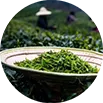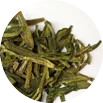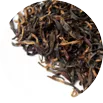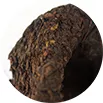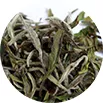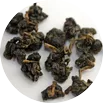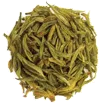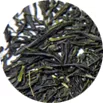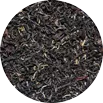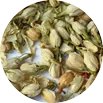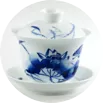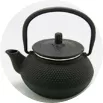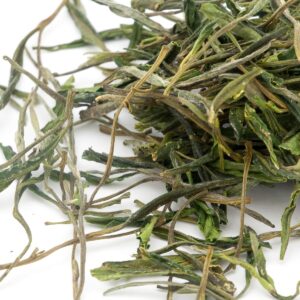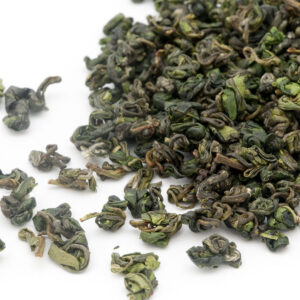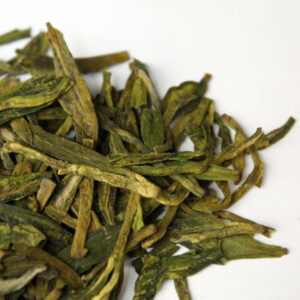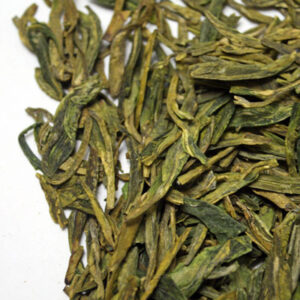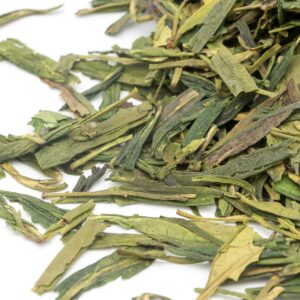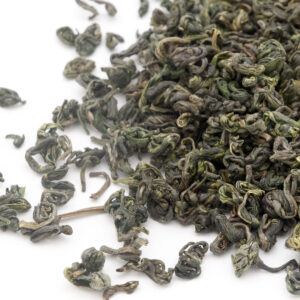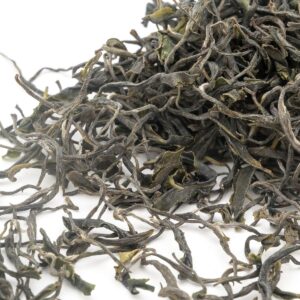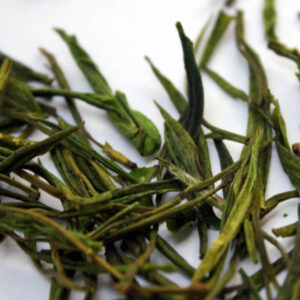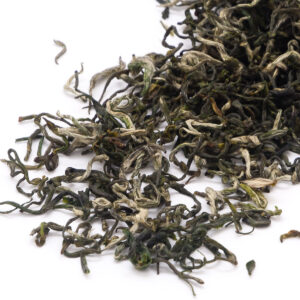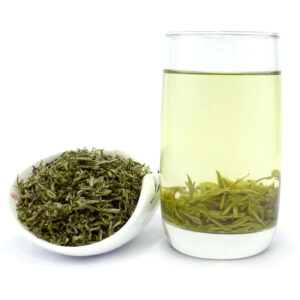Huang Shan Mao Feng Ye Sheng
Lü Bao Shi
Long Jing Shi Feng
Long Jing Xi Hu Superior
Long Jing Xi Hu
Song Luo Ji Pin
Mei Ren Lü
Meng Ding Si Bei Xiang
An Ji Bai Cha
Tai Ping Hou Kui
An Ji Bai Cha Ji Pin
Meng Ding Gan Lu
Green Tea – 绿茶 [lǜ chá]
Fresh, brisk, and invigorating – freshness is an essential qualitative characteristic of green tea, we can recognize it according to the fresh aroma and color of the leaf. Green tea is produced throughout the year, however the best ones come from the Spring harvest and are collected, when their first finest leaves (tips) grow. Green teas are immense diverse, produced from a large number of cultivars by a variety of practices in all the Chinese tea-producing provinces. Green tea has undergone no oxidation.
Manufacture process:
Harvesting: The tea leaves are usually harvested in the early Springtime, between early March and early April, known as the “Ming Qian Cha – 明前茶”. This period is considered ideal, as the leaves are young, tender, and rich in flavour. The leaves are picked by hand, ensuring only the topmost leaves and buds are collected.
Withering: After harvesting, the leaves undergo withering, a process when they are spread out on bamboo trays or racks in a well-ventilated area. This step allows the leaves to lose moisture and become limp, making them more pliable for subsequent processing steps. The duration of withering can range from a few hours to overnight, depending on the desired characteristics of the tea.
Fixation: The withered leaves are then subjected to fixation, also known as “kill-green” or “pan-frying.” This step involves heating the leaves in large deep pans, typically made of iron or stainless steel. The pan-frying process halts oxidation and preserves the green color of the leaves. Skilled tea masters carefully toss and stir the leaves to ensure even heat distribution and prevent scorching. This step also imparts a distinctive toasty aroma to the tea.
Shaping: Following fixation, the leaves are shaped into various forms. The two most common shaping techniques are rolling and pressing.
Rolling: The leaves are rolled, either by hand or using specialized machines. This process helps break down the cell structure, release essential oils, and shape the leaves into tight curls, pellets, or twisted shapes, depending on the tea variety.
Pressing: Some green teas, such as Jasmine Dragon Pearl tea, are hand-rolled into small pearls or balls. The leaves are carefully rolled into tight spheres to preserve their aroma and flavour.
Drying: After shaping, the tea leaves undergo a final drying process to reduce their moisture content. This step is crucial to prevent the growth of bacteria and prolong the tea’s shelf life. Traditionally, the leaves are dried in large bamboo baskets or trays over a gentle heat source, such as charcoal or hot air, for several hours until they reach the desired moisture level. The drying process halts further oxidation and preserves the freshness of the tea.
Sorting and Grading: Once the leaves are fully dried, they are sorted and graded based on their size, shape, color, and overall quality. Highly skilled tea experts evaluate the leaves and separate them into different grades. The sorting and grading process ensure consistency and quality control of the final product.
It’s important to note that the manufacturing process can vary depending on the specific type of green tea. Additionally, modern tea production may incorporate more mechanized processes and advanced technologies while still preserving the essential techniques and characteristics of traditional Chinese green tea.
Due to the fact that green tea is only minimally processed, it retains most of the tea tree leaf after processing: approx. 85% caffeine, 50% chlorophyll and most of the contained vitamins.
Health benefits:
Rich in Antioxidants: Green tea contains high levels of antioxidants, such as catechins and polyphenols, which help protect the body against damage from harmful free radicals. These antioxidants have been linked to various health benefits, including reduced risk of chronic diseases like heart disease, cancer, and neurodegenerative disorders.
Weight management: Green tea has been shown to potentially aid in weight management. It may boost metabolism and increase fat oxidation, helping to burn calories more efficiently. Additionally, green tea has a mild appetite-suppressing effect, which can contribute to controlling calorie intake.
Heart health: Regular consumption of green tea may help improve cardiovascular health. The antioxidants in green tea may lower levels of LDL cholesterol (the “bad” cholesterol) and triglycerides, reduce blood pressure, and improve blood lipid profiles. These effects can contribute to a reduced risk of heart disease and stroke.
Brain function and mental health: The caffeine and L-theanine present in green tea can have positive effects on brain functions. The combination of caffeine’s stimulating effects and L-theanine’s calming properties can enhance focus, alertness, and cognitive performance. Green tea has also been associated with a reduced risk of cognitive decline and a lower incidence of depression and anxiety.
Digestive health: Green tea may support digestive health by promoting healthy gut bacteria and aiding in digestion. It has been found to have antimicrobial properties, potentially helping to combat harmful bacteria in the digestive system. Green tea may also alleviate symptoms of digestive disorders such as irritable bowel syndrome (IBS).
Oral health: The catechins in green tea have antibacterial properties that can help inhibit the growth of bacteria responsible for dental cavities and gum diseases. Regular consumption of green tea may contribute to improved oral health and reduced risk of tooth decay.
Skin health: Green tea’s antioxidant and anti-inflammatory properties may benefit the skin. It can help protect against sun damage, reduce inflammation associated with acne and skin aging, and promote overall skin health.
It’s important to note that while green tea offers potential health benefits, individual results may vary, and it should be consumed as part of a balanced diet and healthy lifestyle. It is advisable to consult with a healthcare professional for personalized advice, especially if you have any underlying medical conditions or are taking medications.
History:
Green tea is the earliest product of the plant named ‘camellia sinensis”. Its cultivation and consumption can be traced deep into Chinese ancient times. According to a famous legend, tea was discovered in 3rd millenium BC by emperor Shen Nong 神农, the mythological founder of Chinese agriculture as well as Traditional Chinese Medicine (TCM), who is said to use tea as a potion against poisonous herbs. In mid 2nd millenium BC, during Western Zhou 西周 Dynasty (11st – 8th cent. BC), tea already served as a tributary item for the Chinese sovereign. During Eastern Zhou 东周 Dynasty (8th – 3rd cent.BC) tea was considered a tasty vegetable and used as an offering during religious ceremonies. In first centuries AD tea already as a tasty and energizing drink slowly started to gain popularity among the Chinese elite called “gentry” or Mandarin officials. They enjoyed tea drinking in their palaces, gardnes as well as while outing in the countryside. A cup of tea in their hand helped them to get inspired for composing poetry or music, for writing calligraphy or painting of a landscape. Many of them lead philosophical talks over the tea. During 5th and 6th centuries tea cultivation and consumption slowly spreaded in buddhist monasteries. From this period there is a very famous story connected to a semi-legendary founder of meditative zen (chan 禅) buddhism, monk Bodhidharma, in Chinese Damo 达摩 (in Japanese Daruma). The legend tells that during his meditation Bodhidharma got tired and fell asleep. After waking up, he got so angry with himself, that he tore his eyelids off and tossed them aside. Suddenly, two bushes of tea grew up on that spot and Bodhidharma decided to make a brew from the leaves. Refreshed and energized by the drink he kept on meditating all along until reaching the goal of all buddhists and attained an enlightment. Ever since then, tea cultivation and drinking is believed to become a ritual practise in buddhist monasteries across the country. It was in the buddhist monasteries, where various methods of tea preparation, serving and drinking were developed and refined.
Tang 唐 dynasty and rise in popularity: Tea cultivation and consuption experienced a significant surge in popularity among all social classes under the reign of Tang dynasty (618-907). Tea cultivation spreaded into many new regions of Southern China and many new methods of serving were developed further. The most wide-spread preparation method of that time was stirring of powdered tea into a frothy beverage – a method that has preserved in Japan for preparing matcha tea until nowadays, but later disappeared in China. There was a fashion of tea houses, tea parties, tea degustation and tea ceremonies, providing opportunities for socializing to various social classes. Meanwhile, in 760 AD “Classical Book on Tea”, litelarly a bible of tea cultivators and tea degustator culture by Lu Yu 陆羽茶经 was published. The Song Dynasty (960-1279) marked a period of refinement and advancement in green tea production. The method of fixation, also known as “kill green” (in Chinese “shaqing杀青”)or “pan-firing” green tea leaves to stop oxidation became more prevalent. This technique helps tea preserve its vibrant green colour, fresh flavor, and natural antioxidants. The Song Dynasty also witnessed the classification of tea into different types, with green tea being one of the prominent categories. Ming 明 dynasty (1368-1644) and Qing 清 dynasty (1644-1912) further contributed to the development and popularity of green tea. Ming dynasty saw the rise of loose-leaf green tea, where leaves were plucked, pan-fired, and rolled into various shapes. It was during this time that renowned green teas like Longjing 龙井 (Dragon Well) from Hangzhou gained fame. In Qing Dynasty, tea trade expanded, and green tea exports reached international markets, contributing to the global recognition of Chinese green tea. Modern Era and Global Influence: In the 19th and 20th centuries, China underwent that impacted tea production. However, green tea continued to be cherished both domestically and internationally. Today, China remains a significant producer of green tea, with various famous varieties like Biluochun碧螺春, Huangshan Maofeng 黄山毛峰, and more. Chinese green tea has become renowned worldwide for its delicate flavors, health benefits, and historical heritage.
The history of green tea in China showcases its deep cultural significance, evolution in processing techniques, and enduring popularity. From its ancient origins to the present day, green tea has held a special place in Chinese traditions and has captivated tea enthusiasts globally with its unique qualities.
Today, China is the world’s largest producer of green tea, followed by Japan, Vietnam, Korea and other countries. Green tea is grown and produced in 18 provinces and approximately 400 thousand tons are produced annually. China’s green tea is the largest export commodity and accounts for roughly 80% of the world’s total green tea trade.
Tea began as a food, gradually became a medicine, a regional drink, a royal prerogative and cultured ritual, a commercial commodity and finally a drink for the masses.


